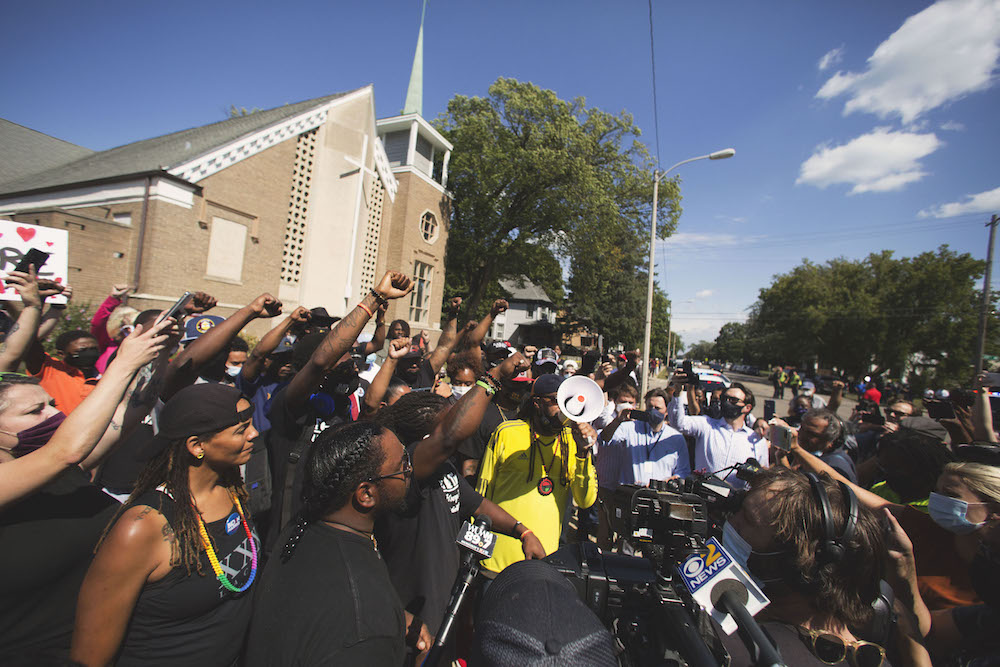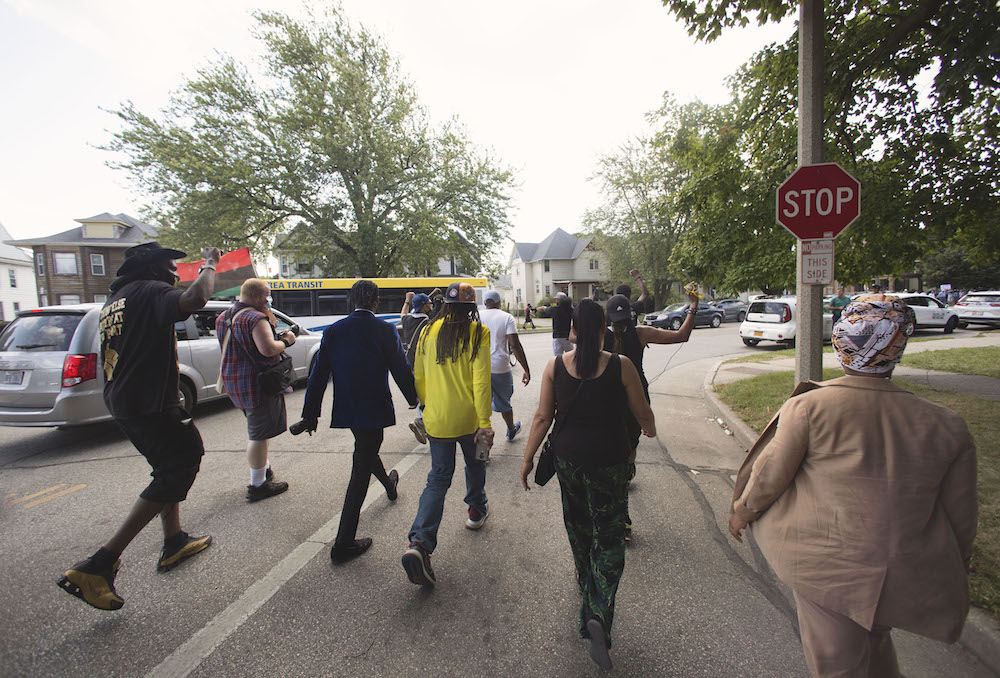KENOSHA, WISCONSIN — We sat in a circle of 15 protestors outside the Kenosha County Courthouse, several hours past the 7pm city curfew. Opposite from the group, and across the street, a pair of federal agents strolled casually behind a black iron fence surrounding the concrete courthouse. The protestors passed around a small megaphone, sharing their experiences, in an attempt to heal from the tragedy that stained the preceding days.

“I’m here for [Jacob Blake] initially,” a young man started. He wore a grey hoodie, tattoos spilling out from under his face mask onto his pale cheeks. “But one of my best friends sacrificed his life for this movement.”
The group echoed the name Anthony Huber, the local skateboarder who was killed by Kyle Rittenhouse, two days prior, on August 26. “I’m sick of seeing people die for no reason, and now it’s close to me. Now I understand.”
To the tattooed man’s side, Anthony Huber’s girlfriend sat cross-legged with her head held low. Her chest pumped, shallow breaths cutting between sobs. Tears ran from her eyes. A friend, a middle-aged black man in a blue baseball cap, came over and put his arm around her.
“Look at this woman. This woman hurt,” the baseball-capped man said. “That’s another reason why I’m here, ‘cause her story touched me so much. I’m here for her.”
The night was quiet aside from the ambient ring of cicadas. Clouds spread east over Lake Michigan, and dim flashes of lightning struck in the distance.

A few nights earlier, there had been thousands protesting the police shooting of Kenosha resident Jacob Blake, but tonight this group of 15 was alone in the street.
The man in the blue baseball cap went on, “Look how many people are out here. In a town of 100,000 people, it’s only us.”
From a distance the sound of grinding engines sped into earshot, and seconds later the screeching of tires – each street tangential to the park square was now lined with blacked out SUVs. Attention snapped backwards to the shuffle of leather boots, as roughly 60 National Guardsmen streamed out of the courthouse, lining up in formation.
The group scrambled up from the circle, off the street, and retreated into the park.
The National Guard held back, (a show of strength in case the 15 unarmed grieving community members decided to act tough), while the police pushed closer from each side, squeezing the group into the middle of the park, pinning them under the bright lamp posts.
“Disperse from the area or we will be making arrests for curfew,” a uniformed man spoke from the PA system of a squad car. The voice was monotone and emotionless, as if announcing, “Now boarding all passengers in group three.”
The man in the blue baseball cap shook his head, “Man, when we peaceful this is what they do to us.” His voice was tired. “They again picking on the weak. Picking on the people that want to sit down and tell they stories, rather than the people that want to burn shit.”
The group was split: stay and face arrest for what they believed was right — standing strong in the face of a politicized police force — or leave, evading needless arrest, but setting a precedent that small nonviolent gatherings can be disbanded at police discretion.
A few protestors argued with the officers, attempting to cut a deal. The police had been routinely arresting lone people after curfew, and the group wanted assurance of safe passage — that they would not be rounded up once dispersed.
“This is not a negotiation,” the spokesman said.
After a final warning, he made the signal. The police broke their line, and streamed into the small group, lunging for protestors. Separating from the group, we dodged left, under the tree shade, and through to a side street. A man was tackled and pinned to the ground. The rest of the group scattered as the most vocal demonstrators were targeted and thrown into squad cars.
The next day, we walked down a dark road along the edge of a cemetery with a reporter and her cameraman. To our right was a burned-out car lot – metallic skeletons, eaten by flames, stained into rust orange.
Earlier that night, we had parked a few blocks down from the courthouse. A group of reporters stood behind concrete barriers, separating the press zone from the park square. At 7pm, the area was practically empty, only a few protestors had shown up. With no activity, the press chatted nervously about what they would report for their live broadcasts. Their audience expected flames, but there were none here tonight.
Catching sideways glances from the credentialed press, we passed through their cement barricades and muscled bodyguards and into the park. Chatting with a few locals, we caught a tip about police activity a mile up the road.
As we set out, a reporter that recognized us from the night before, asked if she and her cameraman could tag along.
“What brought you guys out?” she asked, as the cameraman craned his body low, contorting himself into an angular hunch to record the destroyed vehicles – the results of the destructive protests that ravaged Kenosha following the shooting of Jacob Blake.
“We’re writers,” we responded.
She was disappointed. She had mistaken us for especially motivated protestors.
“That’s too bad, I was hoping to make a story out of you.”
Like many other reporters, the pair had flown out to Kenosha after catching wind of anarchy in the streets, right-wing militias and a seventeen year-old killer, but had been scrambling to find a new angle.
After a mile, it seemed that the tip was a bust, and we flipped around back to the park.
“We’re thinking about driving out to Chicago tomorrow,” the reporter quipped. She figured that with the riots gone and the militia skipping town, there was nothing more to report.
Jacob Blake’s family held a meeting in the park square the following afternoon. Thousands of people had come to attend on this hot saturday afternoon. Blake’s father, Jacob Blake Sr., recounted visiting his son in the hospital. Shackled to the bed, paralyzed from the waist down, Jacob asked him, “Daddy, why did they shoot me so many times?” Blake’s father replied, “Baby, they weren’t supposed to shoot you at all.”
A march splintered off from the rally, and we met a Kenosha resident and protest livestreamer named Nathan, who had captured video footage of Kyle Rittenhouse killing Joseph Rosenbaum.
We asked him what happened last night — why so few people were protesting. “Police are using a snatching technique, and I’m worried that it’s scaring people from coming out,” he told us. “Kenosha is having a bit of an identity crisis. Nobody wants to stand up and be the target.”
The organizer from two night’s earlier who facilitated the discussion circle had been arrested, and had not been back since. Without a clear directive, or an organizer, the handful of protestors that showed up last night eventually went home.
The snatching technique he described, where police use unmarked vehicles to arrest protestors, as well as the presence of federal agents and national guardsmen, was not new — we had seen the technique firsthand in Portland the month before. There however, these tactics only amplified protests, turning what was a strictly Black Lives Matter demonstration, into a BLM/anti-federal law enforcement hybrid (at least in the short term).
The difference was that the number of federal agents called into Portland, a city of 700,000, rivaled the number sent to Kenosha, a city of 100,000. In a much smaller town, it was bluntly apparent how powerful the techniques were.
Where government officials have justified armed federal presence through violence and property damage, the impact of their occupation of American cities might be far more damaging. Military vehicles and camo-clad men with assault weapons patrolling the streets have become normalized over the summer, and Kenosha is a grim example of how far they can be pushed for political ends.
“This shit look like Fallujah,” the man in the blue cap said. “Why so many military hummers for a town of this many people?“.
It’s no wonder people were scared to peacefully protest.
In the days following the shooting of Jacob Blake, Anthony Huber, Joseph Rosenbaum, and Gaige Grosskreutz, the nation erupted into the familiar culture war. Taking their cue, the media descended on Kenosha, working to mine the town for headlines: right-wing Militias, Kyle Rittenhouse the white domestic terrorist, Kyle Rittenhouse the vigilante hero, facism, looting, riots, arson, anarchy, antifa — standing behind their concrete barricades, stripping all complexity to feed our darkest impulses, to generalize and categorize a city and a people we didn’t even know.
“Kenosha, Wisconsin . . . most people had never even heard of us before,” the baseball-capped man said. “You know Kenosha is the first city across from Illinois?” he asked before continuing. “I’m here because [Jacob Blake] got shot seven times. Just imagine being paralyzed from the waist down. That’s why I’m here.”
A national spotlight had beamed on a small midwestern town, poking and prodding, searching for destruction. Then, after the military humvees rolled down 52nd street, pushing anger and hurt out of the streets and into homes, the press vanished, and the country moved on, leaving the community to pick up the pieces — to care for each other.
In the background, Anthony Huber’s girlfriend skated over, the wheels of the skateboard rolling over rough pavement.
“Hey lil miss lady, you alright?” the baseball-capped man asked.
“You know,” she said.





